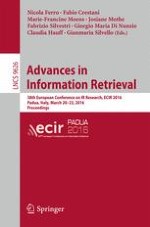2016 | Book | 1. edition
Advances in Information Retrieval
38th European Conference on IR Research, ECIR 2016, Padua, Italy, March 20–23, 2016. Proceedings
Editors: Nicola Ferro, Fabio Crestani, Marie-Francine Moens, Josiane Mothe, Fabrizio Silvestri, Giorgio Maria Di Nunzio, Claudia Hauff, Gianmaria Silvello
Publisher: Springer International Publishing
Book Series : Lecture Notes in Computer Science
